

Compact Muon Solenoid
LHC, CERN
| CMS-PAS-HIN-23-001 | ||
| Groomed jet radius and girth of jets recoiling against isolated photons in PbPb and pp collisions at 5.02 TeV | ||
| CMS Collaboration | ||
| 13 August 2023 | ||
| Abstract: We report the first measurements of the groomed jet radius and the girth of jets in events with an isolated photon recoiling from a jet in lead-lead (PbPb) and proton-proton (pp) collisions at the LHC. The analysis uses pp and PbPb data samples collected with the CMS detector in 2017 and 2018, both at a nucleon-nucleon center-of-mass energy of 5.02 TeV, with integrated luminosities of 301 pb−1 and 1.7 nb−1, respectively. Measurements of inclusive jets point to a narrowing of the structure of jets in PbPb collisions relative to pp collisions. A limitation of such measurements is that the comparison is done at the same reconstructed jet transverse momentum, meaning the scattered parton transverse momentum pT in pp and PbPb collisions differs due to the jet pT loss that happens in the latter case. Since photons do not interact strongly with the quark gluon plasma (QGP), their pT can be used instead as a proxy of the pT of the parton that initiates the recoiling jet shower. We find that jets that more closely balance the photon pT are narrower in PbPb than in pp collisions. On the other hand, jets that balance less the photon pT have an angular structure consistent with the pp reference for the same photon energy. Our measurement indicates, with high confidence, that isolated photons in conjunction with jets provide a better controlled assessment of the modification of the angular scale of jets and of its sensitivity to microscopic properties of the QGP relative to inclusive jet measurements. | ||
|
Links:
CDS record (PDF) ;
CADI line (restricted) ;
These preliminary results are superseded in this paper, Submitted to PLB. The superseded preliminary plots can be found here. |
||
| Figures | |
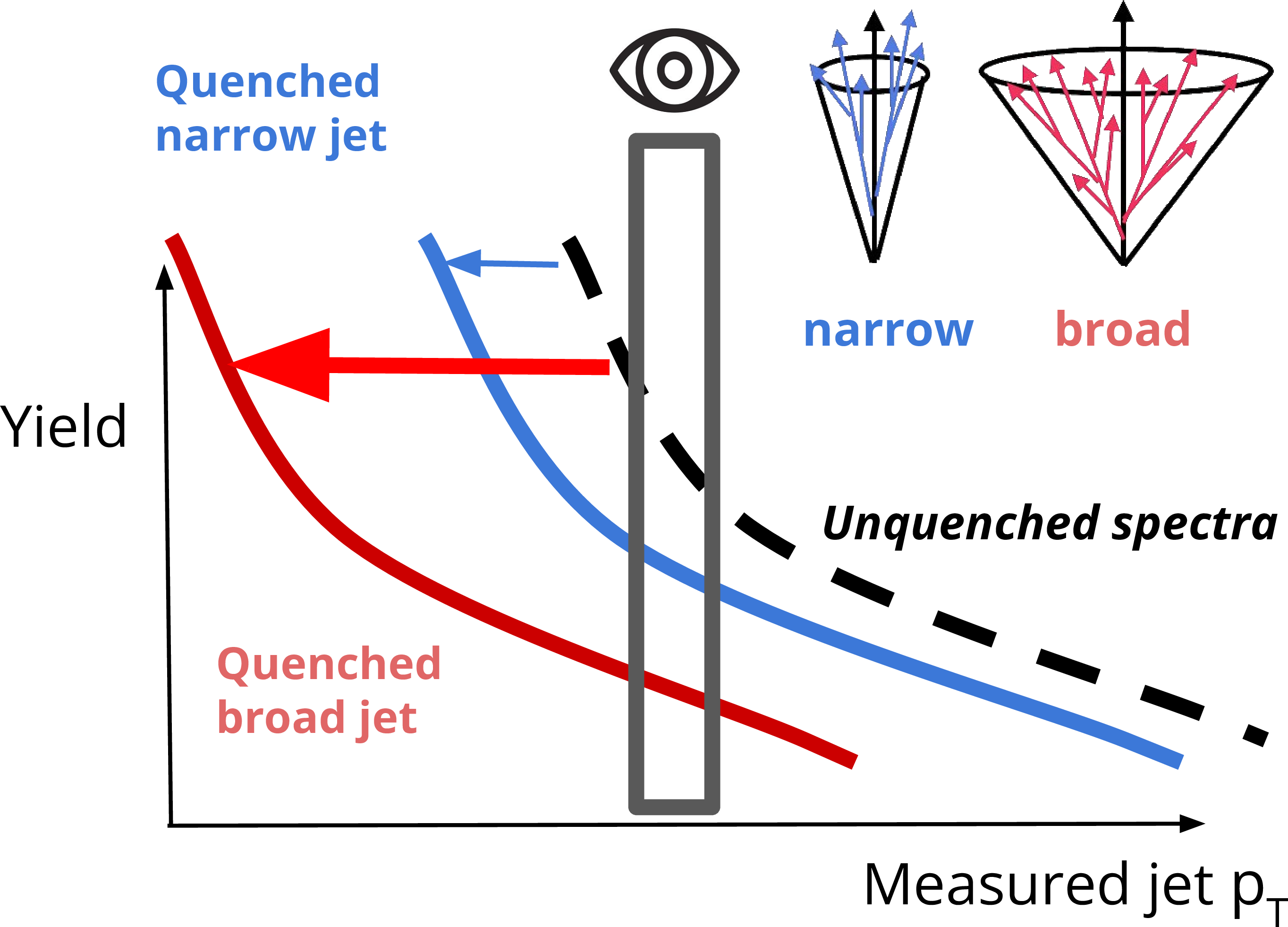
png pdf |
Figure 1:
Schematic diagram of the potential selection bias due to jet energy loss by selecting jets based on the measured jet pT. Broader structures are expected to be more quenched (red line, thicker arrow), whereas narrower structures are expected to be quenched less (blue line, thinner arrow). This can lead to a preferential selection of narrow jets in a given jet pT interval, as indicated by the vertical rectangular box. The dashed line represents the jet pT spectra in absence of jet quenching effects. |
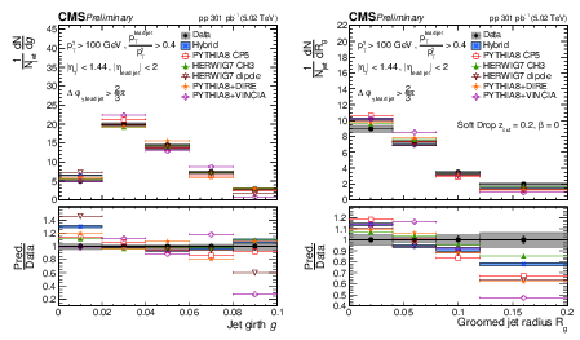
png pdf |
Figure 2:
Jet girth g (left plot) and groomed jet radius Rg (right plot) of jets recoiling from energetic isolated photons in pp collisions for pleadjetT/pγT> 0.4. The upper panels in a given plot show the comparison of the observable in pp collisions and predictions from MC simulated events (for references see text). The lower panels in a given plot show the corresponding ratios of the MC calculations and CMS data. The bands represent the total uncertainties, whereas the vertical bars represent the statistical uncertainties. |
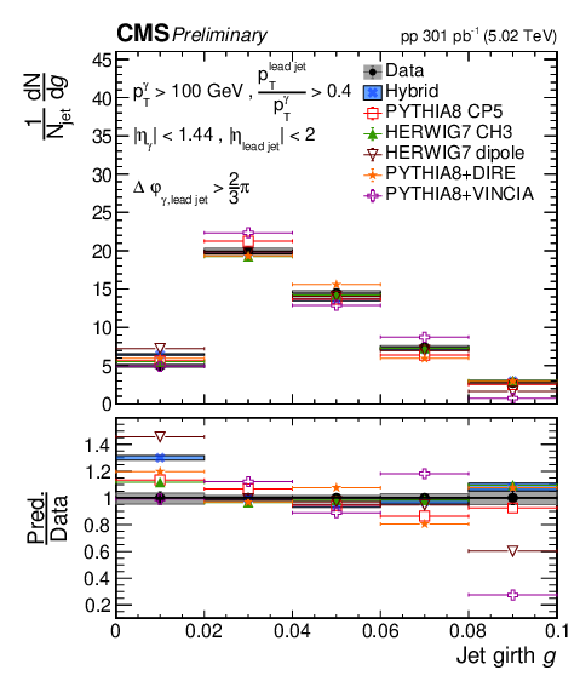
png pdf |
Figure 2-a:
Jet girth g (left plot) and groomed jet radius Rg (right plot) of jets recoiling from energetic isolated photons in pp collisions for pleadjetT/pγT> 0.4. The upper panels in a given plot show the comparison of the observable in pp collisions and predictions from MC simulated events (for references see text). The lower panels in a given plot show the corresponding ratios of the MC calculations and CMS data. The bands represent the total uncertainties, whereas the vertical bars represent the statistical uncertainties. |
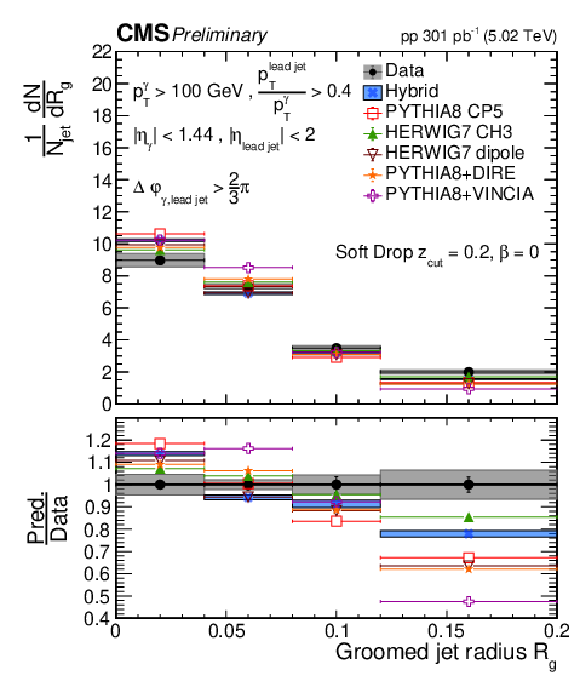
png pdf |
Figure 2-b:
Jet girth g (left plot) and groomed jet radius Rg (right plot) of jets recoiling from energetic isolated photons in pp collisions for pleadjetT/pγT> 0.4. The upper panels in a given plot show the comparison of the observable in pp collisions and predictions from MC simulated events (for references see text). The lower panels in a given plot show the corresponding ratios of the MC calculations and CMS data. The bands represent the total uncertainties, whereas the vertical bars represent the statistical uncertainties. |
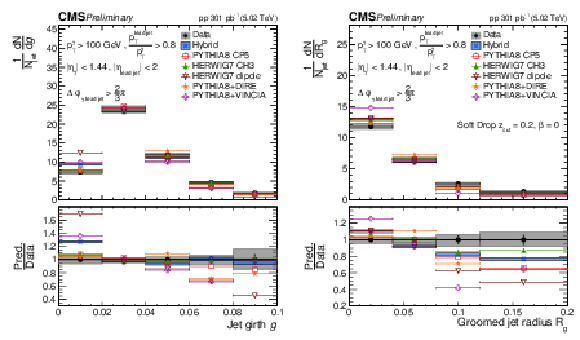
png pdf |
Figure 3:
Jet girth g (left plot) and groomed jet radius Rg (right plot) of jets recoiling from energetic isolated photons in pp collisions for pleadjetT/pγT> 0.8. The upper panels in a given plot show the comparison of the observable in pp collisions and predictions from MC simulated events (for references see text). The lower panels in a given plot show the corresponding ratios of the MC calculations and CMS data. The bands represent the total experimental uncertainties, whereas the vertical bars represent the statistical uncertainties. |
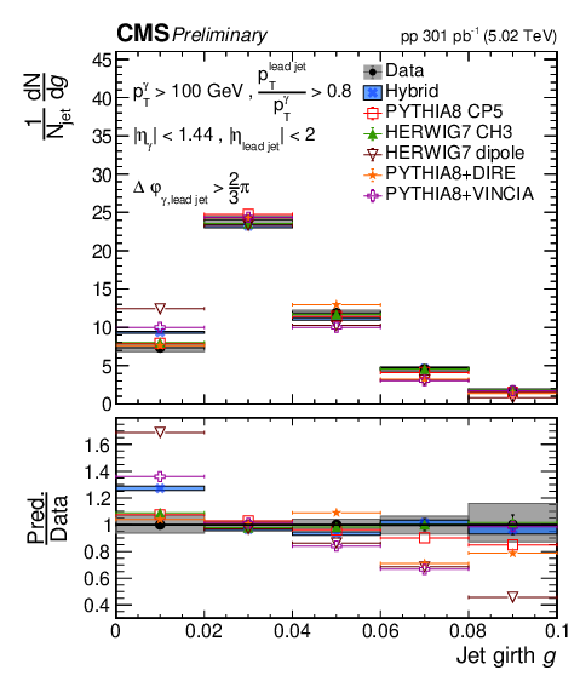
png pdf |
Figure 3-a:
Jet girth g (left plot) and groomed jet radius Rg (right plot) of jets recoiling from energetic isolated photons in pp collisions for pleadjetT/pγT> 0.8. The upper panels in a given plot show the comparison of the observable in pp collisions and predictions from MC simulated events (for references see text). The lower panels in a given plot show the corresponding ratios of the MC calculations and CMS data. The bands represent the total experimental uncertainties, whereas the vertical bars represent the statistical uncertainties. |
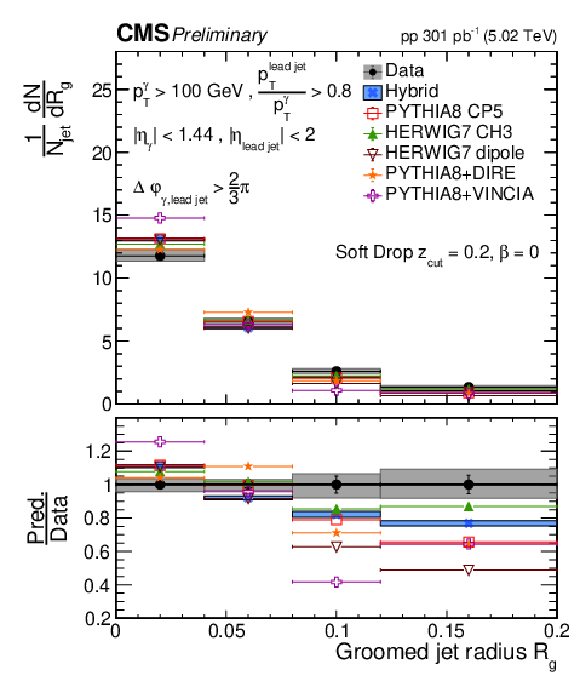
png pdf |
Figure 3-b:
Jet girth g (left plot) and groomed jet radius Rg (right plot) of jets recoiling from energetic isolated photons in pp collisions for pleadjetT/pγT> 0.8. The upper panels in a given plot show the comparison of the observable in pp collisions and predictions from MC simulated events (for references see text). The lower panels in a given plot show the corresponding ratios of the MC calculations and CMS data. The bands represent the total experimental uncertainties, whereas the vertical bars represent the statistical uncertainties. |
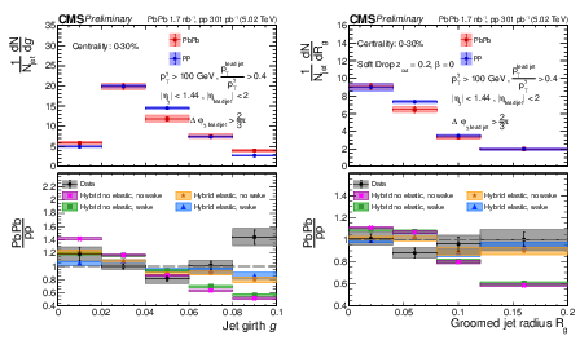
png pdf |
Figure 4:
Jet girth g (left plot) and and groomed jet radius Rg (right plot) of jets recoiling from isolated photons in PbPb and pp collisions for pleadjetT/pγT> 0.4 (selecting quenched and less quenched jets). Top panels: comparison of the observable in PbPb and pp collisions. Lower panels: Ratio of the PbPb to pp measurement compared to MC Hybrid predictions (for references see text). The bands represent the total uncertainties, whereas the vertical bars represent the statistical uncertainties. The uncertainties in the ratio plot are propagated in an uncorrelated way bin-by-bin. |
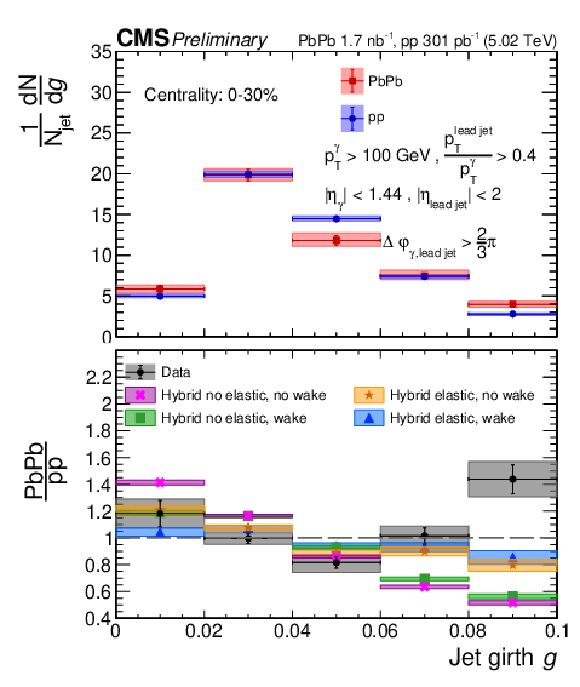
png pdf |
Figure 4-a:
Jet girth g (left plot) and and groomed jet radius Rg (right plot) of jets recoiling from isolated photons in PbPb and pp collisions for pleadjetT/pγT> 0.4 (selecting quenched and less quenched jets). Top panels: comparison of the observable in PbPb and pp collisions. Lower panels: Ratio of the PbPb to pp measurement compared to MC Hybrid predictions (for references see text). The bands represent the total uncertainties, whereas the vertical bars represent the statistical uncertainties. The uncertainties in the ratio plot are propagated in an uncorrelated way bin-by-bin. |
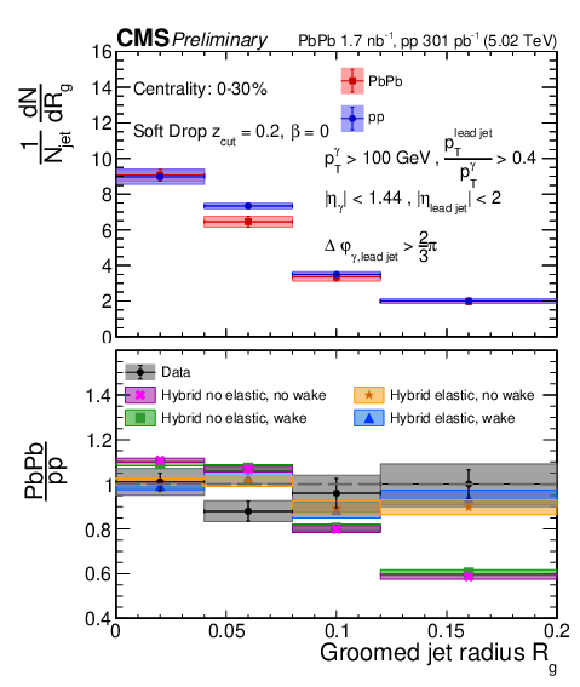
png pdf |
Figure 4-b:
Jet girth g (left plot) and and groomed jet radius Rg (right plot) of jets recoiling from isolated photons in PbPb and pp collisions for pleadjetT/pγT> 0.4 (selecting quenched and less quenched jets). Top panels: comparison of the observable in PbPb and pp collisions. Lower panels: Ratio of the PbPb to pp measurement compared to MC Hybrid predictions (for references see text). The bands represent the total uncertainties, whereas the vertical bars represent the statistical uncertainties. The uncertainties in the ratio plot are propagated in an uncorrelated way bin-by-bin. |
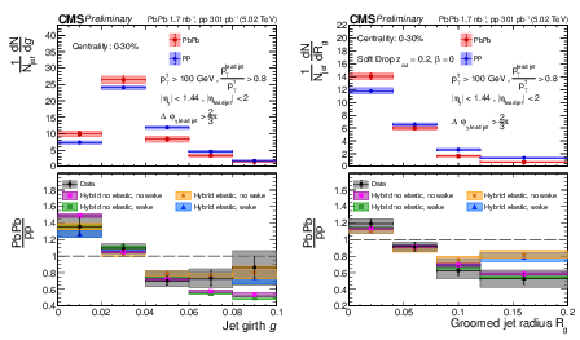
png pdf |
Figure 5:
Jet girth g (left plot) and and groomed jet radius Rg (right plot) of jets recoiling from isolated photons in PbPb and pp collisions for pleadjetT/pγT> 0.8 (selecting less quenched jets). Top panels: comparison of the observable in PbPb and pp collisions. Lower panels: Ratio of the PbPb to pp measurement compared to MC Hybrid predictions (for references see text). The bands represent the total uncertainties, whereas the vertical bars represent the statistical uncertainties. The uncertainties in the ratio plot are propagated in an uncorrelated way bin-by-bin. |
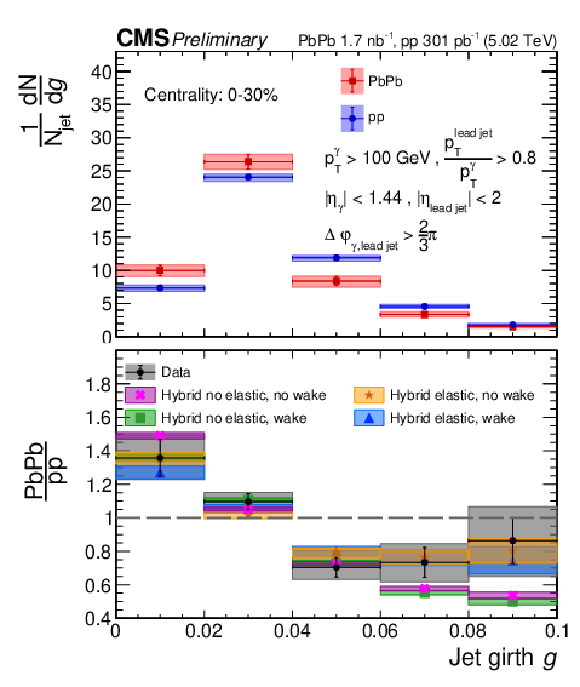
png pdf |
Figure 5-a:
Jet girth g (left plot) and and groomed jet radius Rg (right plot) of jets recoiling from isolated photons in PbPb and pp collisions for pleadjetT/pγT> 0.8 (selecting less quenched jets). Top panels: comparison of the observable in PbPb and pp collisions. Lower panels: Ratio of the PbPb to pp measurement compared to MC Hybrid predictions (for references see text). The bands represent the total uncertainties, whereas the vertical bars represent the statistical uncertainties. The uncertainties in the ratio plot are propagated in an uncorrelated way bin-by-bin. |
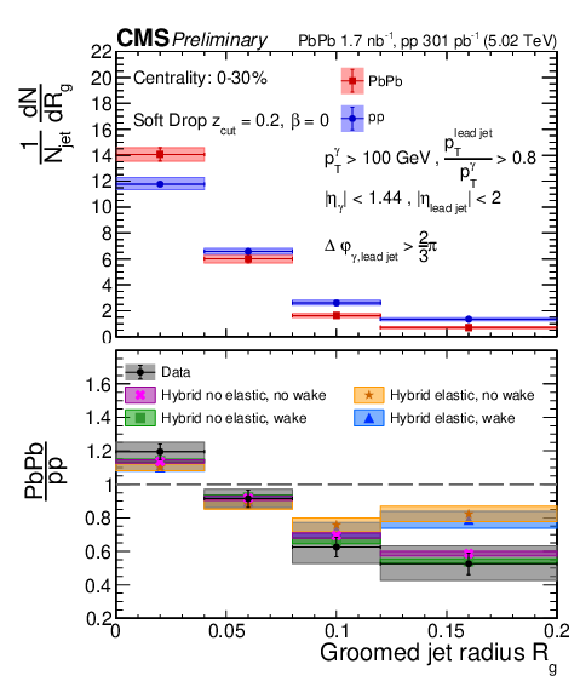
png pdf |
Figure 5-b:
Jet girth g (left plot) and and groomed jet radius Rg (right plot) of jets recoiling from isolated photons in PbPb and pp collisions for pleadjetT/pγT> 0.8 (selecting less quenched jets). Top panels: comparison of the observable in PbPb and pp collisions. Lower panels: Ratio of the PbPb to pp measurement compared to MC Hybrid predictions (for references see text). The bands represent the total uncertainties, whereas the vertical bars represent the statistical uncertainties. The uncertainties in the ratio plot are propagated in an uncorrelated way bin-by-bin. |
| Summary |
| In summary, we reported the first measurement of the distribution of the groomed jet radius Rg and girth g of jets in events with an isolated photon recoiling from a jet in lead-lead (PbPb) and proton-proton (pp) collisions. The analysis uses pp and PbPb data collected by the CMS experiment in 2017 and 2018, respectively. The pp and PbPb data samples, both at a nucleon-nucleon center-of-mass energy of 5.02 TeV, correspond to integrated luminosities of 301 pb−1 and 1.7 nb−1, respectively. The distributions are unfolded to the level of stable particles in order to facilitate comparisons between experiments and theoretical predictions. The transverse momentum of isolated photons pγT can be used as a proxy for the momentum of the high-virtuality parton that initiates the shower of the recoiling jet. This enables us to better disentangle the potential modification of the momentum and angular substructure of jets due to the interactions with the medium from the selection bias effects that can originate from jet energy loss. By controlling the selection bias due to the jet energy loss via pjetT/pγT> 0.4 with pγT> 100 GeV for both pp and central PbPb collisions, we observe no narrowing of the angular substructure of jets produced in PbPb collisions relative to those produced in pp collisions. The level of the residual selection bias depends on the weight of the topologies in which the recoiling jet is quenched more strongly and thus is not reconstructed. By selecting less quenched jets via pjetT/pγT> 0.8, we observe a narrowing of the substructure of jets in PbPb collisions relative to pp collisions. This suggests that selection bias effects play an important role in the interpretation of the modification of the angular scales of jets in terms of medium-induced effects. Our results are compared to a state-of-the-art hybrid model calculations for jet quenching, showing the ability of the data to constrain the building blocks of the shower in the quark-gluon plasma (QGP) medium. Jet quenching is usually assessed by comparing jets and their substructure at the same reconstructed transverse momentum in pp and PbPb collisions, which in the latter case, corresponds to the energy of the jet after the interactions with the QGP. Those interactions are expected to broaden and degrade the energy of the jet shower. As a result, for a given jet pT selection, a selection bias can impact the comparison and lead to an effective narrowing of the distributions in PbPb collisions: the selected jet sample potentially consists of narrow jets that are less quenched while the subsample of broader and more strongly quenched jets has migrated to lower jet energies. Thus, using events with high pT jets recoiling from isolated photons can be used to better constrain genuine medium modifications of the jet shower by controlling the jet energy loss with pγT, complementing measurements in inclusive jet production. |
| References | ||||
| 1 | W. Busza, K. Rajagopal, and W. van der Schee | Heavy ion collisions: The big picture and the big questions | Ann. Rev. Nucl. Part. Sci. 68 (2018) 339 | 1802.04801 |
| 2 | A. Adams et al. | Strongly correlated quantum fluids: Ultracold quantum gases, quantum chromodynamic plasmas, and holographic duality | New J. Phys. 14 (2012) 115009 | 1205.5180 |
| 3 | J. D. Bjorken | Highly relativistic nucleus-nucleus collisions: The central rapidity region | PRD 27 (1983) 140 | |
| 4 | G.-Y. Qin and X.-N. Wang | Jet quenching in high-energy heavy-ion collisions | Int. J. Mod. Phys. E 24 (2015) 1530014 | 1511.00790 |
| 5 | J.-P. Blaizot and Y. Mehtar-Tani | Jet structure in heavy ion collisions | Int. J. Mod. Phys. E 24 (2015) 1530012 | 1503.05958 |
| 6 | J. Casalderrey-Solana and C. A. Salgado | Introductory lectures on jet quenching in heavy ion collisions | Acta Phys. Polon. B 38 (2007) 3731 | 0712.3443 |
| 7 | M. Gyulassy and M. Plumer | Jet quenching in dense matter | PLB 243 (1990) 432 | |
| 8 | R. Baier et al. | Radiative energy loss of high-energy quarks and gluons in a finite volume quark-gluon plasma | NPB 483 (1997) 291 | hep-ph/9607355 |
| 9 | R. Baier et al. | Radiative energy loss and pT broadening of high-energy partons in nuclei | NPB 484 (1997) 265 | hep-ph/9608322 |
| 10 | J. Casalderrey-Solana and E. Iancu | Interference effects in medium-induced gluon radiation | JHEP 08 (2011) 015 | 1105.1760 |
| 11 | Y. Mehtar-Tani, C. A. Salgado, and K. Tywoniuk | Anti-angular ordering of gluon radiation in QCD media | PRL 106 (2011) 122002 | 1009.2965 |
| 12 | J. Casalderrey-Solana, Y. Mehtar-Tani, C. A. Salgado, and K. Tywoniuk | New picture of jet quenching dictated by color coherence | PLB 725 (2013) 357 | 1210.7765 |
| 13 | F. D'Eramo, M. Lekaveckas, H. Liu, and K. Rajagopal | Momentum broadening in weakly coupled quark-gluon plasma (with a view to finding the quasiparticles within liquid quark-gluon plasma) | JHEP 05 (2013) 031 | 1211.1922 |
| 14 | F. D'Eramo, K. Rajagopal, and Y. Yin | Molière scattering in quark-gluon plasma: finding point-like scatterers in a liquid | JHEP 01 (2019) 172 | 1808.03250 |
| 15 | CMS Collaboration | Observation and studies of jet quenching in PbPb collisions at nucleon-nucleon center-of-mass energy = 2.76 TeV | Phys. Rev. C 84 (2011) 024906 | CMS-HIN-10-004 1102.1957 |
| 16 | CMS Collaboration | First measurement of large area jet transverse momentum spectra in heavy-ion collisions | JHEP 05 (2021) 284 | CMS-HIN-18-014 2102.13080 |
| 17 | CMS Collaboration | Study of jet quenching with isolated-photon+jet correlations in PbPb and pp collisions at √sNN= 5.02 TeV | PLB 785 (2018) 14 | CMS-HIN-16-002 1711.09738 |
| 18 | ALICE Collaboration | Measurement of jet quenching with semi-inclusive hadron-jet distributions in central PbPb collisions at √sNN= 2.76 TeV | JHEP 09 (2015) 170 | 1506.03984 |
| 19 | ALICE Collaboration | Measurements of inclusive jet spectra in pp and central PbPb collisions at √sNN= 5.02 TeV | Phys. Rev. C 101 (2020) 034911 | 1909.09718 |
| 20 | ALICE Collaboration | Exploration of jet substructure using iterative declustering in pp and Pb-Pb collisions at LHC energies | PLB 802 (2020) 135227 | 1905.02512 |
| 21 | ALICE Collaboration | Medium modification of the shape of small-radius jets in central PbPb collisions at √sNN= 2.76 TeV | JHEP 10 (2018) 139 | 1807.06854 |
| 22 | ATLAS Collaboration | Measurement of jet fragmentation in Pb+Pb and pp collisions at √sNN= 5.02 TeV with the ATLAS detector | Phys. Rev. C 98 (2018) 024908 | 1805.05424 |
| 23 | ATLAS Collaboration | Measurement of photon-jet transverse momentum correlations in 5.02 TeV Pb + Pb and pp collisions with ATLAS | --190, 2019 PLB 789 (2019) 167 |
1809.07280 |
| 24 | ATLAS Collaboration | Comparison of fragmentation functions for jets dominated by light quarks and gluons from pp and PbPb collisions in ATLAS | no.~4, 04, 2019 PRL 123 (2019) |
1902.10007 |
| 25 | L. Apolin\'ario, Y.-J. Lee, and M. Winn | Heavy quarks and jets as probes of the QGP | Prog. Part. Nucl. Phys. 127 (2022) 103990 | 2203.16352 |
| 26 | L. Cunqueiro and A. M. Sickles | Studying the QGP with jets at the LHC and RHIC | Prog. Part. Nucl. Phys. 124 (2022) 103940 | 2110.14490 |
| 27 | ALICE Collaboration | Measurement of the groomed jet radius and momentum splitting fraction in pp and Pb-Pb collisions at √sNN= 5.02 TeV | no.~10, 01, 2022 PRL 128 (2022) |
2107.12984 |
| 28 | ATLAS Collaboration | Measurement of substructure-dependent jet suppression in Pb+Pb collisions at 5.02 TeV with the ATLAS detector | no.~5, 054909, 2023 Phys. Rev. C 107 (2023) |
2211.11470 |
| 29 | J. M. Butterworth, A. R. Davison, M. Rubin, and G. P. Salam | Jet substructure as a new Higgs search channel at the LHC | PRL 100 (2008) 242001 | 0802.2470 |
| 30 | A. J. Larkoski, S. Marzani, G. Soyez, and J. Thaler | Soft Drop | JHEP 05 (2014) 146 | 1402.2657 |
| 31 | Y. Mehtar-Tani and K. Tywoniuk | Groomed jets in heavy-ion collisions: sensitivity to medium-induced bremsstrahlung | JHEP 04 (2017) 125 | 1610.08930 |
| 32 | H. A. Andrews et al. | Novel tools and observables for jet physics in heavy-ion collisions | no.~6, 065102, 2020 JPG 47 (2020) |
1808.03689 |
| 33 | P. Caucal, E. Iancu, A. H. Mueller, and G. Soyez | Vacuum-like jet fragmentation in a dense QCD medium | PRL 120 (2018) 232001 | 1801.09703 |
| 34 | P. Caucal, A. Soto-Ontoso, and A. Takacs | Dynamically groomed jet radius in heavy-ion collisions | no.~11, 114046, 2022 PRD 105 (2022) |
2111.14768 |
| 35 | J. Brewer, J. G. Milhano, and J. Thaler | Sorting out quenched jets | no.~22, 222301, 2019 PRL 122 (2019) |
1812.05111 |
| 36 | Y.-L. Du, D. Pablos, and K. Tywoniuk | Deep learning jet modifications in heavy-ion collisions | JHEP 21 (2020) 206 | 2012.07797 |
| 37 | J. Brewer, Q. Brodsky, and K. Rajagopal | Disentangling jet modification in jet simulations and in Z+jet data | JHEP 02 (2022) 175 | 2110.13159 |
| 38 | CMS Collaboration | Measurement of the differential cross section for isolated prompt photon production in pp collisions at 7 TeV | PRD 84 (2011) 052011 | CMS-QCD-10-037 1108.2044 |
| 39 | T. Becher, S. Favrod, and X. Xu | QCD anatomy of photon isolation | JHEP 01 (2023) 005 | 2208.01554 |
| 40 | CMS Collaboration | Observation of medium-induced modifications of jet fragmentation in PbPb Collisions at √sNN= 5.02 TeV using isolated photon-tagged jets | no.~24, 242301, 2018 PRL 121 (2018) |
CMS-HIN-16-014 1801.04895 |
| 41 | W. T. Giele, E. W. N. Glover, and D. A. Kosower | Jet investigations using the radial moment | --1885, 1998 PRD 57 (1998) 1878 |
hep-ph/9706210 |
| 42 | R. Kunnawalkam Elayavalli and K. C. Zapp | Medium response in JEWEL and its impact on jet shape observables in heavy ion collisions | JHEP 07 (2017) 141 | 1707.01539 |
| 43 | R.-Z. Wan et al. | Jet shape modification at LHC energies by JEWEL | Chin. Phys. C 43 (2019) 054110 | 1812.10062 |
| 44 | ATLAS Collaboration | Centrality, rapidity and transverse momentum dependence of isolated prompt photon production in lead-lead collisions at √sNN= 2.76 TeV measured with the ATLAS detector | Phys. Rev. C 93 (2016) 034914 | 1506.08552 |
| 45 | CMS Collaboration | Measurement of isolated photon production in pp and PbPb collisions at √sNN= 2.76 TeV | PLB 710 (2012) 256 | CMS-HIN-11-002 1201.3093 |
| 46 | CMS Collaboration | Precision luminosity measurement in proton-proton collisions at √s= 13 TeV in 2015 and 2016 at CMS | EPJC 81 (2021) 800 | CMS-LUM-17-003 2104.01927 |
| 47 | CMS Collaboration | CMS luminosity measurement for the 2018 data-taking period at √s= 13 TeV | Technical Report, 2019 CMS-PAS-LUM-18-002 |
CMS-PAS-LUM-18-002 |
| 48 | CMS Collaboration | Luminosity measurement in proton-proton collisions at 5.02 TeV in 2017 at CMS | Technical Report, 2021 CMS-PAS-LUM-19-001 |
CMS-PAS-LUM-19-001 |
| 49 | CMS Collaboration | The CMS experiment at the CERN LHC | JINST 3 (2008) S08004 | |
| 50 | CMS Collaboration | Performance of the CMS Level-1 trigger in proton-proton collisions at √s= 13 TeV | JINST 15 (2020) P7 | CMS-TRG-17-001 2006.10165 |
| 51 | CMS Collaboration | The CMS trigger system | JINST 12 (2017) P0 | CMS-TRG-12-001 1609.02366 |
| 52 | CMS Collaboration | Electron and photon reconstruction and identification with the CMS experiment at the CERN LHC | JINST 16 (2021) P05014 | CMS-EGM-17-001 2012.06888 |
| 53 | CMS Collaboration | Performance of the CMS muon detector and muon reconstruction with proton-proton collisions at √s= 13 TeV | JINST 13 (2018) P06015 | CMS-MUO-16-001 1804.04528 |
| 54 | CMS Collaboration | Description and performance of track and primary-vertex reconstruction with the CMS tracker | JINST 9 (2014) P9 | CMS-TRK-11-001 1405.6569 |
| 55 | CMS Collaboration | Particle-flow reconstruction and global event description with the CMS detector | JINST 12 (2017) P10003 | CMS-PRF-14-001 1706.04965 |
| 56 | CMS Collaboration | Performance of reconstruction and identification of τ leptons decaying to hadrons and ντ in pp collisions at √s= 13 TeV | JINST 13 (2018) P5 | CMS-TAU-16-003 1809.02816 |
| 57 | CMS Collaboration | Jet energy scale and resolution in the CMS experiment in pp collisions at 8 TeV | JINST 12 (2017) P0 | CMS-JME-13-004 1607.03663 |
| 58 | CMS Collaboration | Performance of missing transverse momentum reconstruction in proton-proton collisions at √s= 13 TeV using the CMS detector | JINST 14 (2019) P07004 | CMS-JME-17-001 1903.06078 |
| 59 | M. Cacciari, G. P. Salam, and G. Soyez | The anti-kT jet clustering algorithm | JHEP 04 (2008) 063 | 0802.1189 |
| 60 | P. Berta, M. Spousta, D. W. Miller, and R. Leitner | Particle-level pileup subtraction for jets and jet shapes | JHEP 06 (2014) 092 | 1403.3108 |
| 61 | O. Kodolova, I. Vardanyan, A. Nikitenko, and A. Oulianov | The performance of the jet identification and reconstruction in heavy ions collisions with CMS detector | EPJC 50 (2007) 117 | |
| 62 | ALICE Collaboration | Measurement of event background fluctuations for charged particle jet reconstruction in PbPb collisions at √sNN= 2.76 TeV | JHEP 03 (2012) 053 | 1201.2423 |
| 63 | CMS Collaboration | Determination of jet energy calibration and transverse momentum resolution in CMS | JINST 6 (2011) P11002 | CMS-JME-10-011 1107.4277 |
| 64 | CMS Collaboration | Jet energy scale and resolution in the CMS experiment in pp collisions at 8 TeV | JINST 12 (2017) P02014 | CMS-JME-13-004 1607.03663 |
| 65 | T. Sjöstrand et al. | An introduction to PYTHIA 8.2 | Comput. Phys. Commun. 191 (2015) 159 | 1410.3012 |
| 66 | CMS Collaboration | Extraction and validation of a new set of CMS PYTHIA 8 tunes from underlying-event measurements | EPJC 80 (2020) 4 | CMS-GEN-17-001 1903.12179 |
| 67 | CMS Collaboration | Development and validation of HERWIG 7 tunes from CMS underlying-event measurements | EPJC 81 (2021) 312 | CMS-GEN-19-001 2011.03422 |
| 68 | GEANT4 Collaboration | GEANT 4---a simulation toolkit | NIM A 506 (2003) 250 | |
| 69 | I. P. Lokhtin and A. M. Snigirev | A model of jet quenching in ultrarelativistic heavy ion collisions and high-pT hadron spectra at RHIC | EPJC 45 (2006) 211 | hep-ph/0506189 |
| 70 | Y. L. Dokshitzer, G. D. Leder, S. Moretti, and B. R. Webber | Better jet clustering algorithms | JHEP 08 (1997) 001 | hep-ph/9707323 |
| 71 | J. Mulligan and M. Ploskon | Identifying groomed jet splittings in heavy-ion collisions | Phys. Rev. C 102 (2020) 044913 | 2006.01812 |
| 72 | M. Dasgupta, L. Magnea, and G. P. Salam | Nonperturbative QCD effects in jets at hadron colliders | JHEP 02 (2008) 055 | 0712.3014 |
| 73 | A. Höcker et al. | TMVA - Toolkit for Multivariate Data Analysis | physics/0703039 | |
| 74 | CMS Collaboration | The production of isolated photons in PbPb and pp collisions at √sNN= 5.02 TeV | JHEP 7 (2020) 116 | |
| 75 | ATLAS Collaboration | Measurement of the inclusive isolated prompt photon cross section in pp collisions at √s= 7 TeV with the ATLAS detector | PRD 83 (2011) 052005 | 1012.4389 |
| 76 | G. D'Agostini | A multidimensional unfolding method based on Bayes' theorem | NIM A 362 (1995) 487 | |
| 77 | T. Adye | Unfolding algorithms and tests using RooUnfold | in orkshop on Statistical Issues Related to Discovery Claims in Search Experiments and Unfolding, H.~Prosper and L.~Lyons, eds., . Geneva, Switzerland, 2011 PHYSTAT 2011 (2011) 313 |
1105.1160 |
| 78 | CMS Collaboration | Study of quark and gluon jet substructure in Z+jet and dijet events from pp collisions | JHEP 01 (2022) 188 | CMS-SMP-20-010 2109.03340 |
| 79 | CMS Collaboration | Fragmentation of jets containing a prompt J/ψ meson in PbPb and pp collisions at √sNN= 5.02 TeV | PLB 825 (2022) 136842 | CMS-HIN-19-007 2106.13235 |
| 80 | W. T. Giele, D. A. Kosower, and P. Z. Skands | A simple shower and matching algorithm | PRD 78 (2008) 014026 | 0707.3652 |
| 81 | S. Höche and S. Prestel | The midpoint between dipole and parton showers | EPJC 75 (2015) 461 | 1506.05057 |
| 82 | J. Bellm et al. | Herwig 7.0/Herwig++ 3.0 release note | EPJC 76 (2016) 196 | 1512.01178 |
| 83 | J. Bellm et al. | Herwig 7.2 release note | EPJC 80 (2020) 452 | 1912.06509 |
| 84 | J. Casalderrey-Solana et al. | A Hybrid Strong/Weak Coupling Approach to Jet Quenching | JHEP 10 (2014) 019 | 1405.3864 |
| 85 | J. Casalderrey-Solana et al. | Jet wake from linearized hydrodynamics | JHEP 05 (2021) 230 | 2010.01140 |
| 86 | D. d'Enterria and J. Rojo | Quantitative constraints on the gluon distribution function in the proton from collider isolated-photon data | NPB 860 (2012) 311 | 1202.1762 |

|
Compact Muon Solenoid LHC, CERN |

|

|

|

|

|

|